#Chaturanga Dandasana Meaning
Text
Chaturanga Dandasana
Chaturanga Dandasana is a challenging but rewarding yoga posture that requires strength, stability, and focus. It is often included in Sun Salutations and other vinyasa yoga flows, and it helps to build upper body and core strength, improve posture, and increase overall body awareness.
However, it's important to approach Chaturanga Dandasana with caution and respect for your body's limitations. Proper form, engagement of core muscles, and alignment are crucial to avoid injury and maximize the benefits of the pose. Modifications and the use of props can help make the pose more accessible and safe.
Regular practice of Chaturanga Dandasana, along with other yoga postures, can help improve physical and mental well-being. Always listen to your body, and remember that yoga is a journey that requires patience, persistence, and self-awareness.
Experts say that Chaturanga Dandasana helps in the proper formation of your body. The special thing about Chaturanga Dandasana is that it is an asana dedicated to the spine, which is done by keeping the spine straight.
For the complete article, Please Visit :-
#Chaturanga Dandasana#Chaturanga Dandasana Benefits#Chaturanga Dandasana Plank Pose#Chaturanga Dandasana Steps and Benefits#Chaturanga Dandasana Meaning#yogaposture#yogapose#yoga postures#yoga#yogaeverywhere#yogadaily#wellness#yogainspiration#positivevibes#healthyhabits#mental wellbeing#wellbeing#self healing#self care#self development#self improvement#selfcare#anxietyrelief#anxiety help#anxitey#anxienty#stress#stress relief
0 notes
Text
Yoga Really *Can* Tone Your Body (Especially If You Do These 6 Poses)
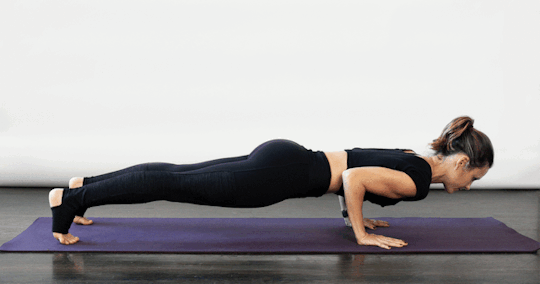
Unless you have actually been living under a rock for the past 5,000 years, you've found out about the several advantages of yoga exercise. A regular yoga exercise technique can erase muscle pains, lead to a far better evening of sleep, offer you a sunnier disposition, as well as boost your mental focus-- as well as that's just the start.
But while the mental as well as psychological advantages of yoga exercise are well-known (and clinically reputable), there's a great deal of back-and-forth over whether pretzeling your legs into pigeon posture counts as stamina work. Yoga's robust health resume typically isn't enough for a lot of strength junkies to ditch their CrossFit, boxing, or HIIT routines for some sun salutations.
But when you take a fast scroll through Instagram, you'll see that a lot of yogis aren't simply flexible-- they're also toned. Like, seriously toned. It begs the inquiry: Can yoga exercise really form a toned body?
Back up-- just what does 'tone' mean?
' Toning' is an expression made use of explain the fortifying and advancement of certain muscle mass teams-- typically your upper legs, arms, or reduced abdominal areas. It's basically a diminished term for 'toughness training.'
But much like lifting weights alone won't put you in figure competition shape, not one single activity will certainly 'tone' your body into that of a svelte prima ballerina. In order for those strengthened muscles to radiate through, you also require to lower overall body fat, which suggests getting your heart pumping on the regular. Cardio (which utilizes fat for power) is crucial, and consuming well is obligatory because-- sorry 'bout it-- you can not out-exercise a bad diet.
' Whatever your physical objectives are, you need a well balanced diet plan if the objective is to be active and healthy overall,' says Alex Silver-Fagan, ACE certified Mirror trainer as well as yoga instructor. Inevitably, to obtain a 'toned' body, the job needs to happen in the kitchen and the gym.
So can yoga exercise count as strength training?
According to Adam Perlman, M.D., an integrative health and wellness and health specialist at Fight it out University, yes.
' There's no doubt about it-- yoga will certainly enhance your muscle mass,' Perlman claims. 'It simply might not be the fastest route to a more powerful physique. Numerous styles of yoga can be efficient for building muscular tissue, and relocating even more energetically via postures causes more calories as well as fat shed, which indicates extra exposure of those muscular tissues.'
Note that when Perlman says 'various designs,' he's not discussing the relaxing, candlelit Yin yoga class that you consistently go to sleep-- I indicate meditate-- during. By all methods, those classes are amazing. They're intended to motivate release and also healing, and also structure muscular tissue requires emphasizing them out.
' All kinds of yoga provide the special chance of marrying your breath to your physical movement as well as are a fantastic means to tune in to your entire body. Extra vibrant, intense yoga exercise is finest for structure toughness-- and also in turn, toning muscle,' states Ceasar Barajas, designer and also instructor of The Journey: NEO U. 'The greater the strength and also the longer the positions are held, the more they will inevitably tone.'
It turns out researchers are wondering the very same thing.
Research in The Journals of Gerontology showed that a normal yoga method was equally as efficient as stretching-strengthening workouts in boosting useful physical fitness in grownups over the age of 60.
A 2nd study published in the Asian Journal of Sports Medicine had 80 individuals do sun salutations six days a week for 24 weeks. At the end of the experiment, these freshly minted-yogis' rep max bench press and also shoulder press revealed a significant increase.
One (super-small) research study performed by the College of Wisconsin-La Crosse asked 15 based on practice yoga exercise for 55 mins three days a week for eight weeks. At the end, researchers discovered an enhancement in their subjects' strength as well as endurance.
So what are the most effective yoga exercise poses for toning?
There are a load! 'Many yoga exercise poses tone various muscular tissue teams in the body by calling for the yogi to sustain their body weight,' Perlman says.
With that in mind, we asked yoga exercise specialists to share their favorite presents for muscle development as well as conditioning. The best component? Absolutely absolutely no of them were positions we would certainly never ever listened to of previously. Think about the below your cheat sheet for understanding muscle-making yoga exercise moves.
1. Bridge Pose
Setu Bandha Sarvangasana
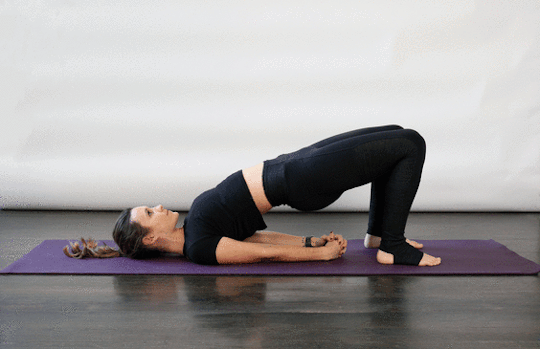
' Do this pose to enhance the muscular tissues in your upper legs and your glutes,' Perlman says.
Start resting on your back, arms at your sides, with your hands dealing with down. Bend your knees, keeping them hips-width apart. Try to get your heels as near to your butt as you can (you must have the ability to touch them with your fingers). As you exhale, push your heels into the flooring to lift your reduced back off the flooring. For a larger backbend, you can vibrate your shoulders with each other as well as intertwine your fingers behind your back. Hold the posture for a number of breaths and reduced your body down. Repeat at the very least 3 times.
2. Plank Pose
Phalakasana

' The kidnappers, obliques, glutes, and also shoulders will obtain stronger thanks to the fixed nature of this present. When done continually-- a minimum of two times a week-- this position can aid create a lean as well as solid midsection,' says Barrie Risman, yoga exercise teacher and co-director of the World Spine Care Yoga Project.
Start on all fours with your fingers spread somewhat. Tip one foot back and afterwards the various other. Your shoulders must be piled over your wrists while your heels press toward the back of the space. Tuck your tailbone so your butt isn't holding up in the air and also expand the area in between your shoulder blades to ensure that your upper body isn't sinking. Squeeze your quads and also glutes and also breathe. Hold for anywhere from 30 secs to 3 minutes (go you!). Repeat 3-5 times, relaxing as needed between sets.
3. Four-Limbed Staff Pose
Chaturanga Dandasana
' Chaturanga is a transitional posture, but it's not one to be rushed with!' claims Jane Kivnik, an instructor at Y7 Workshop in Brooklyn. 'If performed appropriately, chaturanga reinforces not just the arms, triceps muscles, and shoulders, however additionally the stomach wall surface. It's difficult, so it requires our focus as well as kind-- if the mind wanders off, it's a chance to return to the existing and re-engage.'
Start in slab position. As you inhale, run onto your tiptoes so your shoulders take a trip somewhat past your fingertips. Pressing your joints and also biceps in towards your sides, lower halfway down in one straight line and also breathe out. Feel like you're doing a half-push-up? Excellent! Involve your reduced abs to keep your butt in line with the remainder of your body and extend your neck by keeping your gaze ahead as well as down. Chaturanga is an intense posture-- if you feel your reduced back drooping, play it safe and practice this one by boiling down onto your knees and taking the half push-up from there.
4. Chair Pose
Utkatasana

' Chair position is the best quads heater. It's not just the quadricep muscle mass that will really feel the melt but your gluteal muscle mass,' claims Jill Drowne, a learning specialist at Southwest University of Naturopathic Medicine and also Medical Center.
Start in hill present (tadasana) by standing with your feet somewhat apart or your huge toes together as well as a small room in between your heels. Ground down uniformly through your feet, raise up through the crown of your head, and extend via all 4 sides of your waist. Increase your arms and also reach up through your fingertips while launching your shoulder blades down your back. Sit down as if resting right into a chair (therefore the name), changing the weight towards your heels. Preserve the length in your torso while holding the position for 5-8 breaths.
5. Crescent Lunge
Anjaneyasana
' This is a vibrant, full-body posture that produces functional versatility, core stamina, and security and also toning for the legs, butt, and upper body,' claims Bethany Lyons, owner as well as CEO of Lyons Den Power Yoga.
To develop a lunge placement, tip your right foot out in front of you with a 90-degree bend in the front knee as well as the front upper leg bone parallel to the floor. Pile the back heel over the ball-mound of the back foot. Drop the tailbone down toward the flooring by involving your lower stomach muscles. Brush up the arms expenses, shoulder-width range with the palms facing one another. Let your pinky fingers spiral slightly internal. Engage your legs by pressing your back heel behind you and your front knee ahead, paying certain focus to lift the quadriceps muscular tissues of the back leg. Hold for 10 deep breaths.
6. Side Plank Pose
Vasisthasana

' This is another full-body, dynamic position that produces a great deal of warm as it compels the muscle mass to collaborate to produce the alignment and strength needed to hold the present. It delivers toning for the arms, back, shoulders, core, and also legs,' Lyons says.
From a high push-up placement, bring the internal edges of the feet to touch and after that spin your heels to the right ahead onto the right-side edge of the foot. Maintain the legs glued with each other as one as well as the feet fully flexed. Press down into the right-hand man and also sweep the left hand all the way approximately the skies, taking your look with you. The shoulders, hips, and feet need to all be piled for security and power. Involve the core muscle mass and also open the chest. Paying certain interest to not allow the hips sink down toward the flooring, take 5 breaths and then transition through high plank position to the other side. Repeat 2-3 times, taking a remainder between each set.
Ready to get down (dog)?
Yoga definitely can count as strength training as well as can be used to tone your muscular tissues. Bear in mind that there's so a lot even more to yoga than toughness, as well as even if you're exercising every single day, it's far better to integrate yoga into your program than to ditch everything else altogether.
And if you're a beginner, make certain you're discovering the poses safely. 'For the majority of, the best as well as most reliable means is to take courses with a trained as well as qualified trainer who can not just provide support on the most effective presents to target different areas of the body, however can additionally help readjust positions so they are risk-free and also ideal for each and every individual,' Pearlman says.
Gabrielle Kassel is an athleisure-wearing, adaptogen-taking, left-swiping, CrossFitting, New York-based writer with a propensity for thinking of wellness-as-lifestyle. In her spare time, she can be located checking out self-help publications, bench-pressing, or practicing hygge. Follow her on Instagram.
#best workout#best workout routine#exercise#exercise routine#fitness#fitness women#gym#health#health and wellness#physical fitness#weight#wellness#workout#workouts
16 notes
·
View notes
Text
This 15-Minute Yoga-Inspired Workout Will Blast Your Core Into Serious Shape

Have you ever before listened to the stating, 'Abs are made in the cooking area, not the gym'? While that might hold true - considering you need to lose general body fat in order to see meaning in your abdominals - the claiming equally as well may be 'Abs are made on the yoga mat!' Practicing yoga can benefit your body in lots of ways - it is clinically confirmed to decrease anxiety, move lymphatic liquid, and increase metabolic process. All of those points add to assisting you lose body fat, particularly in the stomach location. Mostly all yoga presents strengthen your back as well as core muscles since yoga exercise needs equilibrium, however you can most definitely target your midsection with the best yoga routine.
How Yoga Slims Your Core
Claiming that yoga exercise can assist you get a 6 pack may appear crazy, but there is scientific research to back it up. Many people obtain weight around their belly since of stress. In a research finished by Yale University, researchers discovered that stress and anxiety is specifically wonderful at creating individuals (especially women) to keep fat around the centrally situated organs. This is because of the tension hormone, cortisol. Cortisol exposure raises the natural fat content in humans and also animals - that is the sort of fat that is tough to shed and also collects at the waist and also hips.
Some people are much more prone to cortisol release than others, and that may have something to do with vagal tone. Yet, fortunately is that yoga can enhance your vagal tone and also make you a lot more resistant towards anxiety in time. In short, that indicates that exercising yoga can in fact aid you drop weight and keep it off for longer, getting you out of the stress-related weight gain cycle. And to cover it off, many yoga exercise courses can be found free of cost online, so you do not need to drive to health club or spend for costly memberships.
Compiled listed below is 15-minute yoga exercise that will certainly blast your core into significant form! If you want a longer workout, you can always do it more than once or perform dual the reps on each pose.
Warm-Up With Sun Salutations
Before you jump right in to your ab workout, you want to make certain you are effectively heated up. You can heat up however you like, it simply depends how much time you have. For example, you can take a 1-hour stroll, run for thirty minutes, do 15 mins of jump-roping, or jump on a trampoline for 15 mins. If you like to have a complete yoga exercise exercise, one of the most effective methods to heat up is with Sun Salutations.
And do not let the name fool you - lots of people assume they can only practice Sun Salutations in the morning, and also while there are some wonderful benefits to that, the fact is that you can exercise them any kind of time of day! Sun Salutations are stimulating as well as can get you breath and body in sync, also simply one or two rounds is a pick-me-up that really feels comparable to a mug of coffee. Right here's just how it's done:
Sun Salutation A (Surya Namakar A)
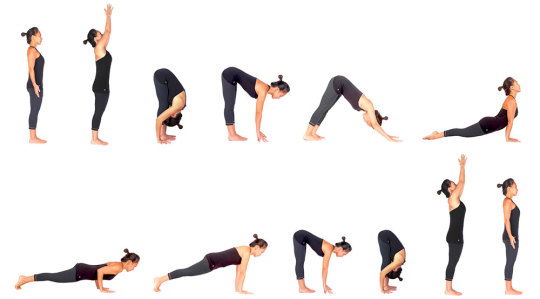
Tadasana-- Standing Mountain Pose
Stand at the front of your floor covering with your feet hip-width apart. Press your palms with each other at your breast bone in prayer placement. Take a couple of deep breaths.
Urdhva Hastasana-- Higher Salute
Inhale as you raise your arms bent on the sides and over your listened to. Delicately arch your back and also stare toward the sky.
Uttanasana-- Standing Forward Fold
Exhale as you fold up ahead from the hips. Bend your knees to take the pressure off your hamstrings.
Ardha Uttanasana-- Fifty Percent Standing Ahead Fold
Inhale as you lift your upper body midway, lengthening your spine forward. You can position your hands on your shins or on the floor, depending on your flexibility.
Chaturanga Dandasana-- Four-Limbed Staff Pose
Exhale as you tip or leap back right into Slab Posture. Lower right into Chaturanga (keeping elbow joints tucked to your sides) and drop your knees if needed.
Urdhva Mukha Svanasana-- Upward-Facing Pet Dog Pose
Inhale as you sweep your upper body forward as well as extend your arms. Attract your shoulders back as well as raise your heart to the sky. If you push through the top of your feet it will certainly help engage your legs.
Adho Mukha Svanasana-- Downward-Facing Pet Pose
Exhale as you lift your hips and also come into Downward Dealing with Pet Present. Bend your knees if you need to as well as make certain your press with your hands. Feel the size in your spin as you attract your hips towards the sky.
Ardha Uttanasana-- Fifty Percent Standing Onward Fold
Inhale as you tip or jump both feet in between your hands. Lift your upper body midway, so that your back is flat. Your hands pertain to your shins or the floor.
Uttanasana-- Standing Forward Fold
Exhale as well as launch your torso over your thighs. Arms can suspend towards your floor covering or your can fold them under your head. Let the upper body release.
Urdhva Hastasana-- Upward Salute
Inhale as you raise your arms bent on the sides as well as over your listened to. Carefully curve your back as well as gaze toward the sky.
Tadasana — Mountain Pose
Exhale as you come back into Mountain Pose. Feet needs to be hip-width apart. Press your palms together at your breast bone in prayer setting. Take a few deep breaths. Repeat as required to cozy up.
Yoga-Inspired Core Workout
Now that you are heated up, it's time to target your core. Here are the postures to get you in the zone:
Setu Bandha Sarvangasana-- Bridge Pose
This pose activates the glutes in addition to the abdominals. Make sure you bring your tummy in as tight as you can to sustain your reduced back while doing this exercise.
Lay on your yoga mat.
Bend your knees and also bring your feet as close to your rest bones as possible.
Exhale, press into your feet, and lift your tailbone upwards so that your butt comes off the floor.
Repeat this activity for 8-10 breaths, inhaling with the upward activity and also breathing out with the release.
Supta Matsyendrasana-- Supine Twist Pose
While this position is typically thought about an unwinding one, you can perform it at a quicker pace to turn on the oblique muscle mass. As an included benefit, this posture is terrific for digestion so it can aid decrease stomach bloating.
Lay on your yoga mat.
Bend your right knee and also cross it over your body towards the floor.
Keep your shoulders square and also glued to the floor.
Exhale to deepen the twist.
Upon launch, inhale while you switch legs and also breathe out to stretch the opposite side.
Perform for 10 breaths total.
Paripurna Navasana-- Watercraft Pose
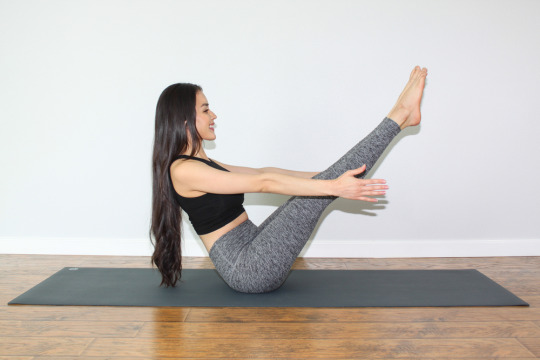
When you think of poses that assistance trigger the core, this one is a no-brainer! If required, you can customize this present by flexing the knees and also keeping them reduced to the ground. Simply see to it your emphasis gets on triggering your core, as well as try your finest not to place excessive stress in the neck as well as shoulders.
Begin in a seated placement with knees curved and hands at your hips.
Keep your spine straight as well as raise your legs off the ground.
Draw your reduced back in as well as raise your chest.
Extend your arms along your sides with hands facing each other.
Focus on keeping your body in a 'V' shape.
Say for 5 breaths or more if you are able.
Marjaryasana — Cat/Cow Pose
The key to activating your core in this posture is to grab the rate! Likewise, make certain you are drawing your reduced belly up and also in to protect your reduced back.
Start in a tabletop position.
Begin with Cow Pose - breathe in to drop your core in the direction of the mat and also raise your gaze upwards.
Draw your shoulder blades away from your ears.
Exhale as well as relocate right into Cat Pose - attract your stomach to your back as well as round your back in the direction of the ceiling.
Let your head reach down to the flooring but don't let it hang, maintain the top body active.
Repeat this series 10-20 times.
High Plank/Side Plank/Upward Plank Rotations

Everyone knows planks are fantastic for your abdominal muscles along with your arms and back! Simply this workout alone will assist tone your body, and enhance your back to make sure that you are much less most likely to obtain harmed doing everyday motions.
Begin in High Plank with your feet somewhat separated as well as your hands shoulder width apart. Drop your knees if it is also intense, but also do not hesitate to push yourself. Slabs are a lot more mental than anything!
Shift your body to the left or right, whichever you prefer to do. All of your weight will certainly relocate to one side as you come into a Side Plank. This can be simplified by going down the bottom leg to the floor.
Hold side space for 2-3 breaths, then roll back for Upward Plank. In this present your arms hold your body up, facing the ceiling.
From right here, present right into Side Slab (on the opposite side this moment), hold for 2-3 breaths, and return to High Plank.
Kakasana — Crow Pose
After a round of slabs, you are all set for Crow Posture! For this one, you might desire a couple of yoga exercise props, especially a yoga block and also a blanket. If you have actually never ever done Crow Position in the past, do not hesitate! It could indicate falling over a few times, yet that becomes part of the joy of yoga exercise - attempting and also improving with time. Also if you can not strike the posture flawlessly, you will certainly enhance your body in the procedure of trying.
Begin in a low squat with the yoga exercise covering folded at the front of your mat. If you are a newbie, begin your squat in addition to the yoga exercise block like a little bird on a perch.
Bring your hands (shoulder width apart) to the yoga floor covering as well as change your weight right into your fingertips.
As you lift your feet up, put your knees into the underarm as well as balance your knees on a little bent elbows. If you are terrified of dropping, you can also position a yoga exercise block under your forehead for support.
Remember, you elbows are like a little rack for your legs! This will aid you maintain stable in the pose.
To appeared, jump the legs back into a plank pose.
Savasana and Meditation
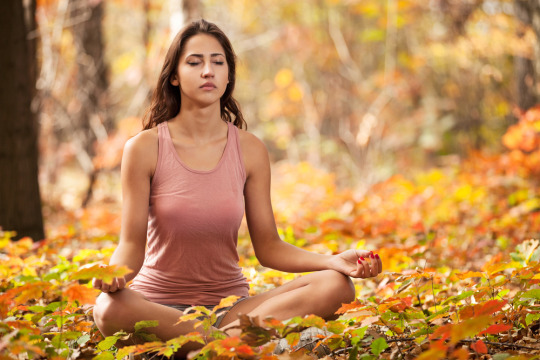
Do not neglect, despite the fact that this is technically a 'yoga exercise workout,' the secret to lengthy term fat burning around the waistline is to minimize tension! Even after you practice a core exercise similar to this one, you must take a minute or 2 for Remains Posture (Savasana) as well as a fast meditation.
If you have problem laying down for Remains Pose as well as feel also restless to relax, try placing an eye pillow over your eyes and also establish a timer for 1-2 minutes. Bring your emphasis to your breath and also simply let every little thing go. This is an outstanding method to promptly lower stress and anxiety, and change your body out of fight-or-flight mode so that you aren't releasing any even more cortisol. And also, if you have the time, adhere to up your final resting position with a quick assisted meditation. This will likewise help you reduced stress levels and also stay wonderful and also fit!
5 notes
·
View notes
Text
Sun Salutation
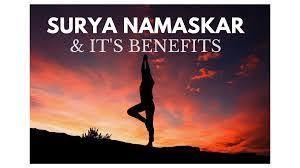
Surya namaskar, the literal meaning of which is Surya (Sun) and Namaskar (to bow down or to greet), hence called Sun Salutation. This specific postural and breathing protocols were developed in India thousands of years ago by a great sage Patanjali. It has been strongly recommended by our Yoga Gurus, all human beings to implement this method in their daily life for good health, illumination, mental and physical stability.
The technique of Sun Salutation is instructed as a series of twelve (12) postures with strict breathing pattern. It is said in yoga world that Sun Salutation is the most significant part during yoga sessions which can be done at a fast pace to get a good workout for cardio-vascular system, and can be done slowly retaining each posture to relax the muscles. it is also considered a form of meditation.
There are numerous health benefits of Surya Namaskar for different systems of human body specially musculo-skeletal, cardio-vascular, gastro-intestinal, nervous system, respiratory system and endocrine system. The heart, liver, intestine, stomach, chest, throat, legs and spine are main benefited organs. By practicing Surya Namaskar each and every cell of our body gets revitalised and regenerated. The regular practice of Surya Namaskar improves blood circulation throughout the body. As a result, we get stronger, flexible and energetic beings. Each Sun Salutation pose helps to burn extra body fat on belly, buttocks and back by modulating glands in endocrine system. It also helps to regulate menstrual cycles among women and also facilitate an easy childbirth. Apart from these benefits of Surya Namaskar, it also help to keep the mind stress free, calm and illuminated. Thus, a regular practice of Surya Namaskar is highly recommended to keep the body and mind healthy.
Below are the steps of each posture along with its technique -
Pranamasana (Prayer Pose) - Stand upright, ensure your feet are balanced and placed close to each other. Take a deep breath, expand your chest and while exhaling relax your shoulders. Join both your palms together as if you are praying.
Hasta Uttanasana (Raised Arms Pose) - Inhale and raise your arms up stretched and above your head. Slightly bend backward. Ensure your biceps must stay close to your ears.
Hasta Padasana (Forward Bending Pose) - Exhale and bend forward from your waist. Try to touch your feet/floor with your hands. However, ensure your spine remains straight. While performing this pose, you should exhale slowly and thoroughly.
Ashawa Sanchalanasana (Equestrian Pose or Low Lunge pose) - Bend your knees slightly, so that the palms/fingers can rest on the floor beside your feet. Take a deep inhale, bring your right knee forward and place your right foot in between your hands. Stretch your left leg backward. Raise your head and make a slight arch at the back, tilting your head.
Chaturanga Dandasana (Plank or Stick pose) - Hold your breath and bring your right leg back as well. Now both your hands will be right under your shoulders. Ensure your body is parallel to the ground.
Ashtanga Namaskar asana (Eight limbed salutation pose) - In this pose, the body touches the ground at eight locations – the head, chest, two palms, two knees, and two sets of toes. Hence, this asana is known as Ashtanga Namaskar. Exhale and slowly bring your knees down touching the floor. Lower your chest touching the floor, Rest your chin on the floor and keep your hips suspended in the air. If done correctly, both your hands, knees, chin and chest will rest on the ground while your hips will remain suspended in the air.
Bhujangasana (Cobra pose) - Straighten your legs and lie on stomach flat on the ground. Position your palms beside your head or chest. Inhale and apply pressure on the hands to raise your upper body. At this point, your head and torso will resemble a cobra with a raised hood.
Adhomukh Svanasana (Downward Facing Dog Pose) - Exhale and gently lift your hips, keeping your palms and feet where they are. Straighten your elbows and knees. Head should become in between the arms, Your body should make an inverted ‘V’. Make an effort to touch your heels on ground.
Ashawa Sanchalanasana (Equestrian Pose or Low Lunge pose) - At this step reverse cycle starts. That way, both legs get the workout done at the same time. Inhale and bring your left foot forward and place it in between your hands. Keep your right leg stretched behind you. Raise your head and make a slight arch at the back, tilting your head, just as in Step 4.
Hasta Padasana (Forward Bending Pose) - Inhale and bring your left foot forward, such that it is next to your right foot. Keeping the position of your hands intact touching your feet/floor, Exhale and slowly bend your torso to enter back into the Hasta Padasana pose, just as in Step 3.
Hasta Uttanasana (Raised Arms Pose) - Inhale and raise your arms up and above your head. Slightly bend backward. Ensure your biceps must stay close to your ears, just as in Step 2.
Pranamasana (Prayer Pose) - Lower your arms while exhaling and stand straight in a relaxed manner. Hold your palms in front of your chest in prayer pose, just as in Step 1. This marks the end of the first set of Surya Namaskar.
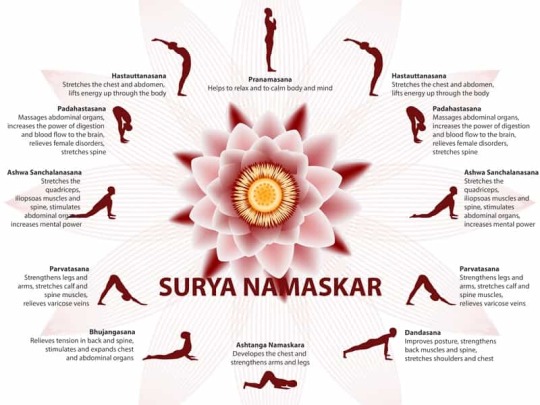
If one wishes to do an intense workout but do not have sufficient time, just do light warm up exercises and perform 12 sets of Sun Salutations that will be equivalent to 288 intense yoga postures. However, if you are a beginner, it is recommended to go slowly, at your own pace. Start with only 5 sets and gradually increase the number every week over a period of time. Once reached at 12 sets, make it a part of your yoga session along with other asanas and breathing exercises.
Fun Fact - With just one set of Surya Namaskar, you burn approximately 13.90 calories.
Common mistakes -
Not doing warm up exercises - Always do light warm up exercises prior to Sun Salutation especially in the morning as the muscles are still tense and might get injured.
Not breathing with the poses as directed - To get maximum benefit, always breath as directed in each pose. Keep in mind the golden rule ‘Inhale while expanding your body, exhale while collapsing your body’. If retaining a pose keep breathing normally at each step, before moving onto next step. Remember to hold your breath at Step 5.
Not being aware of the postures - Pay full attention to each time you make a movement. Focus on which part of the body is getting stretched.
Incorrect Forward Bending pose - There is a tendency of people bending from upper body, that is not correct. Always extend your body forward and then bend from your waist.
Not keeping the body straight in Plank pose - Ensure your body is straight as a plank or stick. If the lower body is dropped towards the floor, it will put lower spine under strain and might develop back pain.
Although Surya Namaskar holds lot of benefits, yet some are advised to refrain or be cautious while performing these poses. Please check it out, if you find yourself falling in one of the below categories -
People with High Blood Pressure - Do not bend all the way down to touch feet/ground at Step no. 3 & 10. The idea is keep your head above your heart. Also, Steps 4, 7 & 9, do not tilt your head back, instead look in front. Keep the sequence at slow pace.
People with Arthiritis - Surya Namaskar involves lot of bending movements, so perform with extra care.
People with wrist injury - Fold a blanket and place underneath your palms while performing steps 5,6,7 & 8. This will raise the angle on wrists and would not put pressure on them. However, if the injury is intense, it is recommended to avoid the sequence.
Heart patients - Consult your doctor before starting this yoga sequence.
Back problems - Consult your doctor or perform under a yoga instructor.
Women on periods, Pregnant and people with hernia - Must refrain from this sequence as these poses might put pressure on the back and abdominal areas.
#yoga#Yoga Inspiration#yogajourney#yogapractice#sun salutation#surya namaskar#mythoughts#yoga education
5 notes
·
View notes
Photo
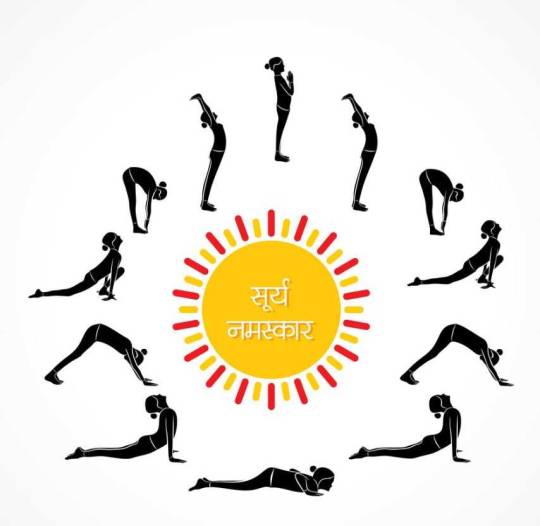
‘Surya Namaskar’ means to pray or bow to the Sun. This yoga asana is the best way to give our body the right shape and keep our mind calm and healthy.
Surya Namaskar is a combination of the 12 most powerful yoga asanas, which is also a good cardiovascular exercise and is beneficial for our health. Surya Namaskar keeps our mind and body healthy.
12 Postures Of Surya Namaskar.
Pranamasana (Prayer Pose)
Hasta Uttanasana (Raised Arms Pose)
Hasta Padasana (Standing Forward Bend Pose)
Ashwa Sanchalanasana (Low Lunge Pose)
Chaturanga Dandasana (Plank Pose)
Ashtanga Namaskara (Eight Limbed Pose)
Bhujangasana (Cobra Pose)
Adho Mukha Svanasana (Downward Facing Dog Pose)
Ashwa Sanchalanasana (Low Lunge Pose)
Hasta Padasana (Standing Forward Bend)
Hasta Uttanasana (Raised Arms Pose)
Pranamasana (Prayer Pose)
For more information visit our site.
https://fitness-classes.com/surya-namaskar-its-poses-and-its-benefits/
1 note
·
View note
Text
8 Asanas for a Healthy Body

In today’s blog, we are going to discuss eight yoga asanas that help to maintain a healthy life with a healthy body.
Yoga has several health benefits if practiced regularly. It affects an individual physically as well as mentally. Moreover, few asanas per day can bring a significant change in your life.
Here we are listing eight asanas for a healthy body which will keep your body healthy in the long run.
Kapalbhati Pranayama
Kapalbhati Pranayama is one of the poses that do not call for much exertion to perform it. However, it is one of the important aspects of yoga.
Before Practicing Kapalbhati Pranayama
Do not practice pranayama by imitating anyone. perform it under a certified yoga teacher or Guru
Try to increase your capacity gradually and not instantly
It is recommended to know more about Pranayama before commencing its practice
If you have any breathing problem or disease then please consult your doctor first
Benefits
Kapalbhati Pranayama has multiple benefits including rejuvenating and de-cluttering of the mind. Likewise, It-
improves the functioning of respiratory organs
advances the working of liver, kidney, and organs of the digestive system
is extremely helpful in PCOS and heart problems
helps in intestinal problems
gives glowing skin
lessens day-to-day stress
Dhanurasana (Bow Pose)
The word “Dhanurasana” is consist of two Sanskrit words- 'dhanur' and ‘asana' which mean bow and posture respectively. It is one of the twelve basic Hatha Yoga. Also, it is one of the best stretching back exercises.
Before Practicing Dhanurasana
Dhanurasana has multiple benefits but one should remember the following points before practicing Dhanurasana. This Asana-
should not be practiced in fluctuating blood pressure
must not be practiced in severe abdominal surgery
is not to be practiced in neck injury
should not be practiced in hernia
ought to be avoided during pregnancy
should not be practiced with a filled tummy
Benefits
Dhanurasana is very helpful in gastrointestinal problems. Other than that, it-
strengthens abdominal and back muscles
makes the back more flexible
improves appetite and digestion
shapes and tones the muscles of legs and arms
helps in the stimulation of the reproductive system
helps in constipation
gives relief in stress and headache
provides relief in cramps and pelvic pain
Uttanasana (Standing Forward Bend)
The word “Uttanasana” is consist of two Sanskrit words- ‘uttana’ and ‘asana' which mean intense stretch and posture respectively. It is a great Asana to soothe the body and mind.
Before Practicing Uttanasana
Before starting Uttanasana, keep the following things in your mind. Uttanasana-
is not supposed to be practiced in case of lower back injury or head injury
should not be practiced in case of heart problems
must be avoided if one is suffering from joint pains
practicing should be avoided in case of abdominal hernia, and sciatica
Benefits
Uttanasana is among the best asana that helps to maintain a healthy lifestyle.
Besides, it-
stimulates the functions of kidney and liver
improves insomniac conditions
helps in stress
stretches the back and shoulders
helps in osteoporosis
improves stimulates blood circulation
strengthens calves and knees
Bhujangasana (Cobra Pose)
The word “Bhujangasana” is consist of two Sanskrit words- ‘bhujang' and ‘asana' which mean cobra and posture respectively. It is considered to be great to practice for all over body fitness. It is also believed to awaken Kundalini.
Before Practicing Bhujangasana
Before practicing Bhujangasana, the following points should be taken into account. This yoga pose-
is not recommended to practice during pregnancy
should be avoided during recent abdominal surgery
is never recommended to be practiced in hernia
must not be practiced in spinal injuries
Benefits
Bhujangasana is extremely helpful in relieving fatigue. Furthermore, it-
soothes cervical pain
strengthens the back, abdomen and hip muscles
provides relief in headache
maintains correct body posture
improves constipation condition
ChaturangaDandasana (Four-limbed Staff Pose)
The word “Chaturanga” is consist of two Sanskrit words- chatur and ‘anga' that means four and limb respectively. Furthermore, “Dandasana” is made up of 'danda' and 'asana' which means staff and asana respectively. It is sometimes also called Low Plank.
Before Practicing Chaturanga Dandasana
Some points to keep into consideration before commencing Chaturanga Dandasana.
This yoga pose-
should be avoided practicing with an empty stomach
must not be done in case of a wrist or spinal injury
is not recommended for those who have Carpal Tunnel syndrome
Benefits
It is one of those yoga asanas that tones down the whole body. Also, it-
revitalizes the body and mind
strengthens wrists and makes them flexible
makes back, arms and shoulders stronger
increases stamina
improves the functions of abdominal organs
ViparitaKarni (Inclined pose)
The word “ViparitaKarni” consists of Sanskrit words- ‘viparita’ which means inverted and ‘karni’ which means‘doing'. It is one of the few poses that help in anti-aging with other benefits.
Before Practicing ViparitaKarni
Some factors given below should be taken care of before practicing this asana.
Remember ViparitaKarni-
must be avoided in case of severe eye problem
is not advised to practice in case of a recent knee injury
should not be practiced by hernia patients
should be avoided by pregnant women
Benefits
ViparitaKarni is quite beneficial for patients of low blood pressure. Moreover, it-
helps in detoxification of blood
stimulates immunity
is helpful in insomnia
massages abdominal organs
works as a stress buster
is therapeutically beneficial for varicose veins
Setu Bandha Sarvangasana (Bridge Pose)
The term Setu Bandha Sarvangasana is a derivative of the Sanskrit words. The setu means “bridge," bandha, means "lock," sarva, means "all," anga, means, "limb," and asana means "pose." It is a basic vinyasa form of yoga.
If one is suffering from any injury or sickness, always consult a doctor.
Before Practicing Setu Bandha Sarvangasana
Always keep the note of the following points:
Perform it under the guidance of a yoga expert
If one is suffering from any injury or sickness, always consult a doctor
Setu Bandha Sarvangasana should be avoided in severe back problems
It helps in the reduction of anxiety and stress
Pregnant women should practice it strictly under an expert’s supervision
Benefits
One of the most prominent advantages of practicing Setu Bandha Sarvangasana is that it relieves negative emotions and calms the mind. In addition, it-
is helpful in the treatment of Asthma
stimulates lungs and abdominal organs
stretches and strengthens the lower body as well as upper body
stimulates digestive system
improves blood circulation
Shavasana(Corpse Pose)
The word “Shavasana” is consist of two Sanskrit words- shav and ‘asana' which mean corpse and posture respectively. It is generally performed in the last session for the relaxation. It is used to reduce tiredness and provide relaxation after a long yoga session.
Before Practicing Shavasana
One should take care of the following things while practicing Shavasana:
Stay calm and concentrated
Do not fall asleep
If you feel drowsy, take fast breaths to avoid it
Do not lie on your back for long if you have back problems
Benefits
Shavasana is a yoga asana of deep healing. It might be simple to practice but it has multiple benefits. Doing at the end of a yoga practice session, it
provides relaxation and calmness to the body
controls blood pressure
helps to be more concentrated and focused
makes the body feel rejuvenated
brings peace to the inner self
These are the eight asanas of yoga which, if practiced regularly, can bring constructive and optimistic transformations in one’s life.
These asanas help you to make you the best version of yourself. To go into a deeper approach, you can join yoga TTC of 200 Hour or 300 Hour level. Besides, if you are new to yoga, you can join yoga for beginners or a yoga studio for proper guidance.
1 note
·
View note
Text
Anatomy 101: Strengthen Your Big Toes to Build Stability
Sometimes the tiniest adjustment makes all the distinction in exactly how comfy and also secure you feel in a yoga exercise posture. Consider your huge toes, for instance. You may believe they function subconsciously, specifically throughout tasks such as stabilizing on one foot. Paying more interest to, and adjusting, your huge toes during asana method can reinvent your positioning as well as equilibrium, instilling a soothing sense of groundedness. The following time you are in Uttanasana (Standing Onward Bend), notice where the weight in your feet is. A lot of us practice with our hips back and also our weight in our heels. This stops you from stacking your bones in a means that permits you to support, as well as could strain your hamstring attachments at the hips. A straightforward, mindful big-toe adjustment can create security in the bones, ligaments, and also muscular tissues of the feet, enhancing the mind-body link and also producing a safe and secure foundation for secure and easily aligned poses.
So exactly how does the anatomy work? Muscle mass in your large toes support the tendons and also bones that comprise your arcs. Healthy and balanced arches( instead of fallen ones) imitate shock absorbers, transferring kinetic pressures, or the pressures of motion, up with the ankles to the knees and also up the kinetic chain of the body, potentially triggering concerns with placement, joint health, and also muscle stamina. For example, weak big-toe flexors, the muscle mass that flex the toe, could alter the stamina as well as efficiency of your biggest glute muscle, gluteus maximus. And also the glute max is critical in supporting most positions. For the big-toe muscular tissues to do their job well, securing your body from influence as well as instability, they require to be dynamically steady, indicating they need to reply to shifts in movement, weight, as well as balance.
The good news is that you could train your huge toes. In a position like Standing Forward Bend, uniformly push the fleshy part of the large toes right into the floor covering. Do not grasp the toes, instead, imagine you are delicately pressing a switch with them. This button-pressing action could reinforce the big-toe flexors to awaken the kinetic chain of muscle mass on the back of the leg and bring the hips into placement above the ankle joints. After you strengthen your big-toe flexors, you'll intend to stretch them using positions like Chaturanga Dandasana (Four-Limbed Personnel Posture) as well as Adho Mukha Svanasana (Downward- Facing Canine Posture). Both extending and enhancing workouts are had to maintain vibrant stability in the toes.
Getting a lot more acquainted with the anatomical structures in the soles of the feet, likewise called the plantar surface area, will assist refine your awareness of how you can engage the huge toes. Your big toe is made up of 2 joints: The metatarsophalangeal (MTP) joint attaches the long bone (metatarsal) of the front of the foot with the very first bone in the large toe (phalanx). It develops the pile at the base of the sole of the huge toe. The interphalangeal (IP) joint is the big-toe knuckle. Pills (ligamentous cavities that confine joints) as well as tendons cover and cross both joints, providing static stability.
Finally, let's take a look at just how these joints move. Bending your big toe is regulated by two muscular tissues: the flexor hallucis longus (FHL) and also the flexor hallucis brevis (FHB). They are helped by the abductor as well as adductor hallucis muscle mass. The FHL comes from the inmost part of the back of the lower leg, under the calf bone, as well as attaches through tendon around all-time low of the foot to the base of the IP joint. The FHB flexes the MTP joint. All these muscles sustain your arcs. Lightly weighing down with the big toe maintains security in the MTP joint and turns on the kinetic chain of muscle mass from the soles of the feet to the hamstrings and glutes. While you cannot transform the ligaments, capsules, and also bones knowingly, you could service moving the muscular tissues to build stamina and also security in standing balance poses.
4 Poses to Touch Your Toes' Power
Try the yoga poses listed below for developing stamina as well as wheelchair in the muscular tissues supporting the large toes, after that observe the changes in your perception of feeling rooted as well as balanced.
Standing Forward Bend, variation
Uttanasana
From Tadasana (Hill Pose), breathe in to lengthen your back, then exhale to hinge from the hips to fold up. When the pelvis drifts back in this present in yoga class, the teacher commonly will certainly drop by and gently press it onward to straighten the legs perpendicular to the flooring. When the educator leaves, the pelvis has a tendency to wander back once more. Right this on your own by carefully pushing the fleshy part of the big toes right into the mat, which can help bring your femurs into a more upright position over your ankles. Press the outdoors sides of your feet into the mat to trigger your arcs. You ought to feel grounded. Hold for 5 to 10 breaths before going back to Mountain Pose.
Chair Pose, or Fierce Pose
Utkatasana
With your big toes with each other and also heels slightly apart, inhale to extend your arms along your ears as well as bend your knees, lowering your glutes into Chair Posture. Press the fleshy component of the large toes down, after that add the external sides of the feet to balance the arcs. Function your way up the body, pushing the knees together (all while holding the action in the feet), after that involve the buttocks. Note how this connects the large toes to the core, through the kinetic chain of muscular tissues as well as fascia, or connective tissue, from the soles of your feet via the rear of the legs. Hold for 5 breaths.
Extended Hand-to- Big-Toe Pose
Utthita Hasta Padangusthasana
Stand in Hill Pose. Stabilizing on your left foot, elevate your right knee. Cover your best index and also center fingers around the best large toe as well as proactively bend your toe against your fingers as you gradually function to align your leg. Bring your recognition to the connection of your right big-toe flexor's origin on the back of the lower appropriate leg. This present actively enhances and also stretches your big-toe muscular tissues. Hold for at least 5 breaths before switching sides.
Four-Limbed Staff Pose
Chaturanga Dandasana
This is a counterpose to stretch the toe flexors, especially the FHB. Come to Plank Posture and slowly lower down, seeing to it your joints more than your wrists, your arms are alongside the flooring, which your shoulders do not dip reduced compared to your elbows. Reach back with the heels and make certain you are piling them over your toes, and also that your toes are crinkled under. After that press your huge toes to shake onward, filling the stretch. Go slowly, and also if you experience discomfort in the MTP joint, back off a little bit. Hold for 5 breaths prior to releasing.
5 notes
·
View notes
Photo
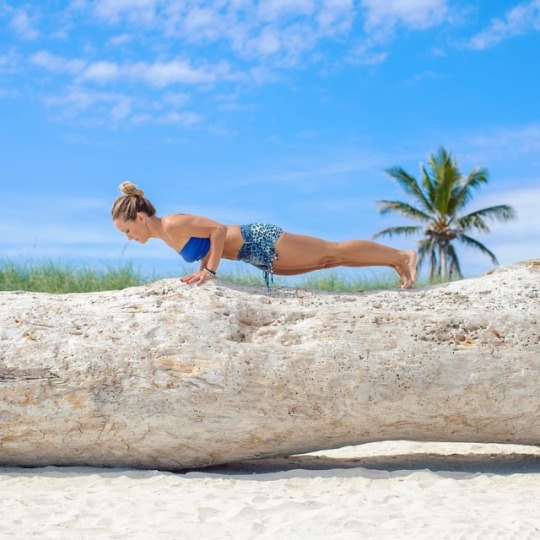
I don’t always have my stuff together. In fact sometimes I am such a mess that I lose it completely for no real reason at all. I’m not proud of those moments of total chaos but I do realize it’s a part of being human and I accept it. Today was one of those days where a perfect storm of emotional mess erupted all over. After running late all morning, reading one annoying email after another, teaching all day, my back muscles hurting and my head about to explode I had a meltdown. Tim was good enough to leave me alone although he did almost get caught in the crossfire. After a little bit of time and some air (I go for walks to clear my mind), I could breathe again. Maybe things are reaching some kind of crescendo. Or maybe there’s a part of me that’s just had enough and has reached some sort of a limit. Or maybe it was just a long day. Either day, I don’t believe being a yogi means that you’ll be perfect. Instead I think it means that when these things arise you look at them with a clear mind and a compassionate heart. We are all doing the best we can. And we are clumsy so much more often than we are graceful. Love and forgiveness give us space to stumble and fall and get back up to try it all again with a little more humility and a little more wisdom. The path is long but it arches gently towards peace. _ Day 22 #30dayyogaliving is Chaturanga Dandasana with @tylandrumyoga on @omstarsofficial Outfit @liquidoactive Photo @ifilmyoga _ #practiceyogachangeyourworld #onebreathatatime 🙏 (at Miami Beach, Florida)
32 notes
·
View notes
Photo

Chatur means four; anga means limbs; Danda means staff (here, it refers to the spine of the body); asana means pose. It is pronounced as cha-thur-anga Dhan-daa-sana. This pose is frequently practiced as part of the Surya Namaskar or Sun Salutation pose. Benefits of Chaturanga Dandasana/ four-limbed staff pose This asana strengthens the wrists, arms, and shoulders. It also helps straighten the spine, and strengthen the back and abdominal muscles. It helps keep the body aligned, maintaining core stability. It helps increase stamina. Sportspersons do the plank pose as part of cooling down exercises after playing. This pose is also a follow-up pose after the adho mukha svanasana or downward-facing dog pose. Pic by - @alleil.ulleil For more details Visit & share - www.shambuyoga.com Or Dm us at +91-8077026732 #mayanku_ #mylifmyyogaindia#mylifemyyoga #hathaflow #ashtangayoga #yogachampion #instapic #dailyyogapractice #dailypics #viralpost #viralpics #tedtalk #todayyoga #healthbulletin #yoganews#influencers #amazoninfluencer #startupindia #uttrakhand_dairies #startuputtrakhand#vocalforlocal #supportlocal #joinup #rishikesh_photography #yogattcinrishikesh #yogaretreat2020 #yogafestivals #durgapuja2020 #naturephotograpy #navaratri2020 (at Rishikesh - Yoga Capital of the World) https://www.instagram.com/p/CGrSk40DZbb/?igshid=1atxf6g255rlg
#mayanku_#mylifmyyogaindia#mylifemyyoga#hathaflow#ashtangayoga#yogachampion#instapic#dailyyogapractice#dailypics#viralpost#viralpics#tedtalk#todayyoga#healthbulletin#yoganews#influencers#amazoninfluencer#startupindia#uttrakhand_dairies#startuputtrakhand#vocalforlocal#supportlocal#joinup#rishikesh_photography#yogattcinrishikesh#yogaretreat2020#yogafestivals#durgapuja2020#naturephotograpy#navaratri2020
0 notes
Photo
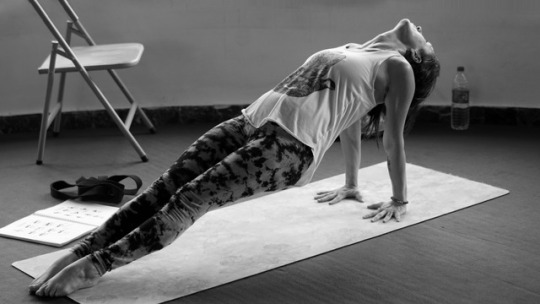
Purvottanasana (Upward Plank Pose)
is an intermediate back-bending yoga pose that builds strength and flexibility. It is sometimes used as a counter-pose to forward folds, such as Paschimottanasana (Seated Forward Fold) , and full-body, strength-building poses, such as Chaturanga Dandasana (Four-Limbed Staff Pose) .
The Sanskrit name for this pose, "Purvottanasana" (PUR-voh-tun-AHS-uh-nuh), actually translates to "Intense East Stretch." This comes from four words:
“Purva” — meaning “east"
“Ut” — meaning “intense”
“Tan” — meaning “to stretch”
“Asana” — meaning “pose”
Ancient yogis practiced facing eastward as the sun rise, so the front side of the body (facing the sun) was considered the “east” side. This pose provides a deep stretch, which can feel intense. Just remember not to push the pose too far. Injuring yourself just to gain a deeper stretch is not the goal of yoga. Take it slowly and modify the pose as necessary. With time, you may find Purvottanasana invigorating, instead of intense!
Benefits of Upward Plank Pose :
This pose simultaneously strengthens and stretches your shoulders. It strengthens the arms, upper back, legs, glutes, and wrists; and stretches the chest, abdomen, tops of the feet, and ankles. This pose builds core strength while challenging and improving balance, as well. Regularly practicing Purvottanasana helps calm the mind, increases energy levels, and is also therapeutic for fatigue.
14 notes
·
View notes
Photo
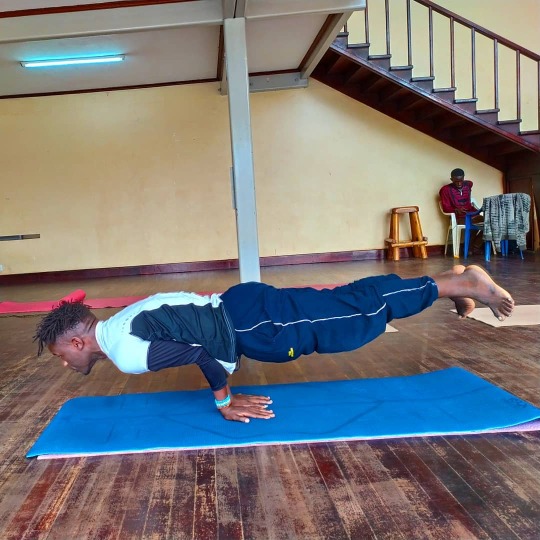
Mayurasana (Peacock Pose)-Steps And Benefits In Sanskrit, Mayur Stands for Peacock and meaning of Asana is Pose or Posture. As indicated by the Indian mythology, the peacock is a symbol of love and everlasting status. Mayurasana is said to take after a peacock when it struts around with its plumes down. Peacock Pose has a mess of advantages, and in spite of the fact that it looks entangled, with a little practice, Mayurasana (Peacock Pose) is very simple to do. Style of Asana: – Hatha Yoga. Level of Asana: – Intermediate. Preparatory Poses: – Eka Pada Shirshasana, Chaturanga Dandasana. Follow-Up Poses: – Balasana, Eka Hasta Bhujasana, Bhujapidasana, Adho Mukha Svanasana, Dwi Hasta Bhujasana. Steps of Mayurasana (Peacock Pose) Start this pose by sitting on your heels. Keep some distance between your both knees. Keep your hands on the ground with fingers points towards your body. Slowly bend your elbows and press them towards your belly. Keep your abdomen firm. For this place your head on the ground, and work up the quality in your stomach. Now stretch your legs out, in a way that your knees are straight and your feet are facing the floor. Keep your shoulder bones strong and pushed into your back. Fix your bum and lift your head and look forward. Move your body weight forward and raise your legs from the ground. Lift your body by your hands and it should be parallel to the ground. Remain in this pose about 30 seconds and you can increase the holding time about one minute by daily practice. After that put your head and feet on the floor and release the pose. Benefits of Mayurasana Peacock Pose removes toxins and detoxifies your body. Improves the function of digestive system and makes abdomen stronger. Peacock Pose is beneficial in piles and diabetes. Strengthens and tones your reproductive system. Mayurasana Improves sexual activity. Makes your elbows, wrist, spine, and shoulders stronger. Mayurasana improves your posture. Reduces anxiety and stress and give calmness to the mind. Increases your focusing power of the mind. NOTE: If you have an injury in your shoulder, elbow or wrist, shoulder or elbow, then avoid this. #sharing #yogateacher (at Kampala, Uganda) https://www.instagram.com/p/B6u8TfuBXF2/?igshid=1olk8ynlknqyy
0 notes
Text
5 reasons why teaching alignment matters
You've most likely, eventually, been instructed to Stack your knee over your ankle in Warrior 2 or Align your shoulders over your wrists in Slab present. Just recently there has actually been much conversation in the yoga exercise world regarding whether or not yoga exercise instructors ought to give so many anatomical positioning signs like these.
As a passionate SAFE YOGA EXERCISE lover as well as a 6-year professional makeup educator of yoga teachers-in-training, my reply is a loud and unquestionable 'YES' to comprehensive and also smart placement cues. Below are 5 of my factors why:
1 FEEL ME, TOUCH ME, HEAL ME: Straightforward body awareness
When I was asked lately in a meeting why I think individuals need to practice Hatha yoga exercise, my response was: 'Yoga allows you to have the alternative experience of your body and also where it is positioned, at any kind of moment, in area as well as time ... basically the superb experience of being entirely symbolized, of sensation greatly ALIVE."
The bulk of trainees concerning exercise yoga for the very first time are hardly knowledgeable about their body as a whole. The majority of individuals experience themselves as parts ... fragmented.
The majority of trainees practicing yoga for the very first time are barely mindful of their body in its entirety. The majority of people experience themselves as parts ... fragmented.
Life has a means of doing this to us: throwing us curve sphere after captain hook (work, worries, traumas) and afterwards desensitizing us from the concerns that have built up in our tissues. I inform my teachers-in-training constantly that one of our many vital tasks as yoga teachers is to put 'Humpty Dumpty' back with each other again so she or he can go back into their lives and also do whatever it is that they do (for work or play) around again ... with zest, vitality, and incredible sense of feeling complete.
Alignment cues motivate people to concentrate their minds on a certain body component, the signs instruct them how to relocate (within their very own variety of motion), location it as well as infuse it, exactly how to feel it if it is tight, tense or restricted in some method. This then opens up the trainee approximately the much deeper understanding of their body and the myriad of possibilities (as well as realities) of much less pain as well as pain and even more liberty, simplicity as well as array of movement (where perhaps they were even not aware there was none).
2 THAT ARE YOU? Stiring up to one's physical regular patterns
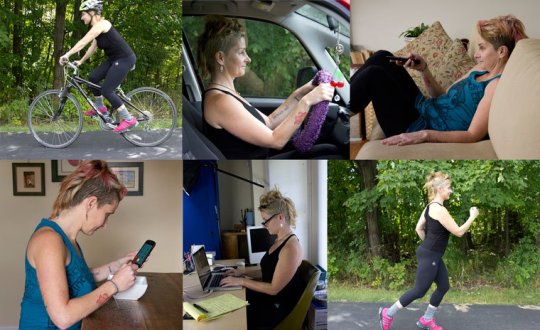
Whether it be from resting at a desk all day, driving a car for a work, training for a marathon or bicycle race or resting on your stomach with your head relied on the right for three decades - habitual patterns have been established in your body that will detrimentally affect (deteriorate) the body as a whole.
Whether it be from 'automatic' activities inscribed over a lifetime, mishaps, psychological traumas or considerable life occasions, purposeless habitual motion patterns will negatively affect (weaken) the body as a whole.
Also, deposit from accidents, emotional traumas or large life events like growing, birth as well as lugging a baby on your hip will certainly establish regular patterns in the body that are not useful to the body's continuous attempts to achieve vibrant stability (natural state of harmony, balance and also radiant health and wellness).
The human body is composed of regarding 300 joints and each joint has a specific quantity of all-natural activities done by certain agonist (key mover) and synergist (assistant) skeletal muscles. In order for the body to be radiantly healthy and execute at its maximum degrees efficiently, all connective tissue (bones, tendons, muscular tissues, ligaments and fascia) require to fully experience the equilibrium of toughness as well as suppleness - not as well tight, strained or limited in one area and also loosened or weak in another.
Teachers that show bone placement additionally require to show correct muscular tissue activation - informing their pupils on what skeletal muscular tissues move and also position the bones in certain shapes (presents and counterposes). This is so essential for both on- and also off-the-mat long life, if we have the knowledge as well as the experience of how to appropriately relocate the body we will be much less prone to soft tissue wear as well as tear and the risk of injuries will be diminished.
3 GRAVITY: Always a factor
As we continually and also continuously exercise the numerous various designs of Hatha yoga, working to experience the body-breath-mind union, we will undoubtedly obtain more powerful, more flexible, more able to experience feelings of entire body vibrancy as well as buoyancy. Up until after that we usually land on the mat experiencing the reverse: thickness, tightness, with a body that seems fragmented (experiencing the individual components versus the fantastic sum whole).
Sometimes I believe us older, wiser (wink, wink) and seasoned yoga exercise educators neglect what it felt to be a new yoga professional: puzzled, uncoordinated, clumsy, weak, incapable to float, fly or also stabilize! My partner, Dan, came up with an excellent example for this:
If you sent out a number of seasoned/master yoga educators (all asanas executed easily, pranayama techniques mastered, bandhas flawlessly engaged, reflective minds totally as well as utterly concentrated on their drishtis) on a school trip to a world where gravity is a lot different to ours below on planet (as if the air was like the consistency of honey) and asked them to exercise yoga exercise like they do back residence ... they will inevitably check out each various other and also ask HOW do we navigate these bodies? Where are the inhabitants of this earth ... can they educate us exactly how to move as well as position our bodies in such a method we won't obtain hurt?
I enjoyed this analogy of his! What would it really feel like to be a beginner once again ... to be educated how to relocate your body in a means that defies the restraints gravity puts upon it?
What would it seem like to be a newbie once again ... to be educated just how to move your body in a manner that opposes the constraints gravity puts upon it?

We all have had the experience (as well as if you are reading this as well as it hasn't took place yet ... IT WILL!) of a position that we battled, sweated and also vowed with, that with attentive technique, became unbelievably easy as well as stylish. Alignment-based yoga instructors are instructing basic bone-stacking as well as muscular tissue activation standards (not all positionings help all body kinds, obviously) so that the student can discover this ease, the free-flow of pranic power that is so Sukha sweet!
4 SECURE YOGA ROCKS: Tendons are not elastic
Wrong placement - breaking the natural functioning order of the bones and joints - of one's body parts can place feasible injurious stress and anxiety on the surrounding connective tissue - especially when gravity is a factor! A reality to keep in mind: tendons are not flexible! As soon as stretched from their original form they will never ever return to their original form. As a result of this, it is not beneficial to the ligaments to 'hang' on your bones in a stretch - again, especially when gravity is a factor.
Once extended from their original shape ligaments will never ever return to their original form. Due to this it is not helpful to the ligaments to 'hang' on your bones in a stretch.
For example, in a posture with a greater center of gravity such as Warrior 1 or 2, the knee ought not to surpass the stacked ankle/heel. Or else, the quantity of pressure that the upper leg bone put on the kneecap ligament as well as the knee joint tendons can cause injury - both from recurring movement and also traumatic. A reduced centre of gravity posture such as Low lunge doesn't necessarily have the exact same quantity of pressure on the knee. Some knees, even in such a low pose, should also not pass through past the ankle/heel.
Another instance is to make certain your shoulders do not dip listed below your joints in Chaturanga

Dandasana. This puts unneeded (and also damaging) weight on the tendons, ligaments and bursas of the shoulder girdle and the arm joint. Be aware of keeping the ribs in line with the parallel-to-the-earth upper arm bones in this reduced slab posture. By not allowing the ribs to dip reduced you prevent any kind of unneeded load-bearing anxiety on the tendons of the sternoclavicular and acromioclavicular joints.
For lots a lot more on this read For the love of the shoulder as well as Our complex shoulders and also Chaturanga Dandasana
It is ok, however, to have the shoulders lower than the elbow joints as you relax on the floor as well as prior to you use your back muscle mass to peel your body off the mat in Bhujangasana (Cobra Posture) since your alignment to gravity is reduced (resting on the ground) as well as you're using your erector spinae muscle mass (back extensors) to lift your body off the mat.
Up to this factor all these examples I have discussed have been ones I have actually experienced many various other yoga exercise experts struggle with discomfort, pain and injury in.
A last example is one I have actually directly experienced. I am a hyper-extender of the knees, without any muscular tissue activity I have 'dropped' right into the rear of my knees given that I was a child. Well, this quality of mine was celebrated in a details kind of hot yoga I have actually been lovingly exercising considering that 1999 where a recurring sign is to 'lock your knees, lock your knees, secure your knees'. Easy for a hyper-extender such as myself to do ... every class, 6 days a week for two years directly I secured my knee in 6 standing postures (higher facility of gravity, labelled weight bearing as well as 4 of them getting on one leg just). The tendon damage in my knees is so considerable that occasionally I stumble when I stroll because I am so unstable there. Now, when I practice that kind of yoga exercise (I still like as well as value the collection sequence) I micro-bend my knee to shield this valuable joint - a crucial safety and security alignment hint not normally offered but is vital for the health and wellness of the tendons of the knee!
5 BE BELOW CURRENTLY: Atha Yoga exercise Anushasanam

Lastly, one of one of the most yogic factors for teaching and exercising alignment-based yoga exercise: GREATEST EXISTENCE IN THE SPIRITUAL NOW. One of the most profound utterances besides AUM is the sanskrit work ATHA which means CURRENTLY. Yoga suggests union and also among the lots of translations of this principle of unity is the body-mind-breath-spirit link that truly can just be feasible RIGHT NOW. This minute. RIGHT HERE. NOW. Are you right here? Where are you? Are you planning or fretting about the future? Are you feeling resentment or regret about what occurred in the past? Are you right here being, breathing, experiencing the magic that is constantly unraveling or are you ... oops, you simply missed it. Currently, below it is again. Be here currently ... and also currently ... as well as currently ...
Are you below? Where are you? Are you below being, breathing, experiencing the magic that is constantly unfolding or are you ... oops, you just missed it.
Teachers that continuously teach their trainees exactly how to align their bodies in such a way that one of the most Sthira (stability) as well as Sukha (comfort) will be experienced are supplying their pupils something to concentrate their minds on. For 60, 75 or 90 mins the trainee's mind is paying attention to the instructor, paying attention to their body's toughness as well as weak points, paying attention to their breath to locate both obstructions as well as liberty. Throughout this moment there are no bother with the children, the costs, the one in charge, the aging and also troubling parents, etc. Essentially, alignment based courses are meditations right into the now, where the body actually moves, changes and relaxes. The mind likes to desert the body ... placement based yoga exercise offers the pupil a means to the body, a back to the NOW.
Read all the articles in Jennilee's collection on protecting against yoga exercise injuries:
The breath, prana as well as the vayus
The bandhas
Bone alignment
Muscle intelligence
Joint integration
2 notes
·
View notes
Photo
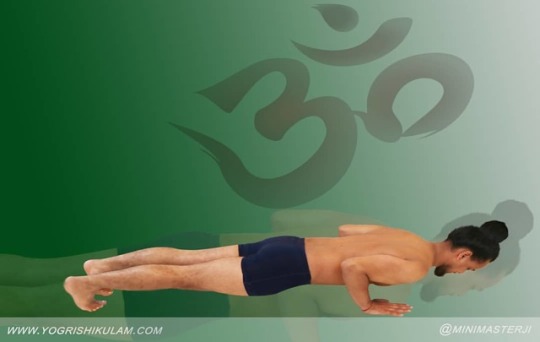
चतुरङ्ग दण्डासन Chaturanga Dandasana (chah-tuur-ANGH-uh dahn-DAHS-uh-nuh) is a major component of Ashtanga Yoga. The full name comes from four Sanskrit words: "Chatur" — meaning "four" "Anga" — meaning "limb" "Danda" — meaning "staff" "Asana" — meaning "pose" Chaturanga Dandasana or Four-Limbed Staff Pose, With the exhalation, move into Plank Pose or the top of a push up. In this initial position, the middle or index fingers face forward and the hands are slightly wider than the shoulders. The elbows point backwards, not out to the sides. The shoulders are actively pulled away from the ears so they do not compress the neck nor rotate inward, collapsing the chest. This action engages the many muscles that support the shoulder blades while reducing tension in the neck. Note: With experience and speed, you may move from Ardha Uttanasana to the bottom of Chaturanga with one exhalation. If you wish and need to practice more slowly, then move into Plank Pose with the exhalation and then pause to inhale, then lower with the exhalation. @minimaster_at_yogrishi_kulam www.yogrishikulam.com #minimasterji #minimasteryog (at Minimaster ji) https://www.instagram.com/p/B0oYUO2DnW0/?igshid=fp5im0az7g3t
0 notes
Photo
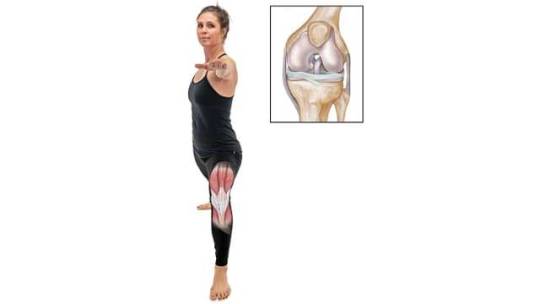
New Post has been published on https://fitnesshealthyoga.com/how-to-keep-your-knees-safe-and-injury-free-during-a-yoga-class/
How to Keep Your Knees Safe and Injury-Free During a Yoga Class
Anatomy of the knee
PHOTO: CHRISTOPHER DOUGHERTY; ILLUSTRATIONS: MICHELE GRAHAM
In 2007, I slipped while descending a steep trail in Shenandoah National Park. I took a hard blow to the outside of my left knee, shredding the lateral meniscus and articular cartilage and dislocating the kneecap. I faced major surgeries to save the knee from a partial joint replacement. My orthopedic surgeon was upfront: Recovery would be long and arduous. More than anything else, my mindset would be the key to my healing. That meant I needed to cultivate a nurturing relationship with my knees.
Thanks for watching!Visit Website
Fortunately, prior to the accident I’d been a yoga practitioner with a daily meditation habit for 19 years. Before surgery, I dedicated an hour a day to channeling love and gratitude into my knees. By the time I was wheeled into the operating room for the first of two surgeries that ultimately restored the joint’s structure, the knee had become my most beloved body part. I had learned to celebrate its complexity and vulnerability, and to fine-tune movements to treat it well. The knee is the body’s nexus of faith and duty: One of the first things we do when we seek strength or mercy is get down on our knees. We also drop to our knees when we pledge ourselves to a path of devotion. Each knee is the grand arbiter of mechanical forces received from the foot and hip. For better or worse, the knee adjusts itself to balance and transmit the energies of impact, shear (sliding forces), and torsion (twisting forces).
Thanks for watching!Visit Website
Thanks for watching!Visit Website
See also Essential Foot and Leg Anatomy Every Yogi Needs to Know
The knee is often described as a hinge joint, but that’s not the whole story. To the eye, it resembles a hinge because its primary movements are flexion (bending, to draw the thigh and calf toward each other) and extension (straightening, to move the thigh and calf away from each other). In reality, the knee is a modified hinge joint. It glides, and rotates. This makes it more versatile but also more vulnerable. Its range of motion becomes clear when you compare it with the elbow. Bend and straighten your elbow several times. The movement feels similar to opening and closing a laptop. Try it again by moving between Plank Pose and Chaturanga Dandasana (Four-Limbed Staff Pose). Now try Virabhadrasana II (Warrior Pose II), placing your front hand on the inner part of your front knee. Bend your front knee (flexion) and feel the thigh bone, or femur, glide forward and rotate—moving the knee up and out. Straighten your knee (extension) and feel the femur glide backward and rotate—moving the knee down and in.
To keep stable, the knee relies on tendons, ligaments, cartilage, and the joint capsule itself, not large muscles. Among standing yoga poses, Tadasana (Mountain Pose) is most stable for the knee because there is maximal contact between the end of the femur and tibial plateau (the top of the tibia, or shin bone). Things go awry, though, if you “lock” your knees. When we hyperextend—and many of us do so without conscious thought—we excessively squeeze the anterior, or frontal, aspect of the menisci (see drawing), pushing the tissues backward, out of their natural placement. Instead, practice standing with your knees in a “relaxed straight”: stand and press back through one of your knees. Then firm your calf muscles toward your shin bone. Notice how all your leg muscles engage. Take your attention to the middle of your knee. It should feel very stable. Practicing this action over time will reeducate your muscles and correct hyperextension. Also, the inner parts of the knee are larger, thicker, and deeper than the outer parts. This anatomical asymmetry makes it normal for the kneecaps to slightly glance toward each other in poses such as Tadasana and Adho Mukha Svanasana (Downward-Facing Dog Pose). Perhaps you’ve heard the cue to point your kneecaps directly forward in straight-leg asana? Don’t do it; it can injure the knee because it overrides the structure and function of the joint.
See also Anatomy 101: Are Muscular Engagement Cues Doing More Harm Than Good?
The knee is least stable when bent. When we flex our knees, as in Virabhadrasana II, we have less contact between the femur and tibia. When there is less bony contact, connective tissues strain and become more vulnerable. The vastus medialis, the inner muscle of the front thigh, is primarily responsible for keeping the patella, or kneecap, in its femoral sulcus, the groove at the end of the thigh bone. Ideally, we want the kneecap to slide smoothly up and down that groove, so that the patella functions efficiently as a fulcrum when we bend and straighten the knee. But the vastus medialis is much smaller than the vastus lateralis, on the outside of the front thigh. This strength imbalance in the front thigh muscles, or quadriceps, can cause the kneecap to pull out and up, creating pain in everything from walking to bent-leg standing asana. Lunge poses often make it worse. But we can develop balance between the muscles through “quad setting.” Sit in Dandasana (Staff Pose) with a rolled towel under your knees, toes pointed up. Press out through your heels. Then, press down through your knees, leading with the inner knee. Hold for 10-20 seconds, release, and repeat to fatigue.
Remember, the knees, stuck in the middle, absorb energy from the feet and hips. If you take them beyond normal rotation or put too much pressure on them when bent, you increase the risk of harming your ACL. In turn, several poses demand a high degree of caution. Some I’ve stopped practicing altogether.
Bhekasana (Frog Pose): Places strain on the ACL and medial meniscus because of torsion from trying to draw the soles down and toward the outer hips.
Virasana (Hero Pose): When practiced with the knees together and feet outside the hips, we push maximal range of motion for most people and add rotational strain multiplied by body weight.
Padmasana (Lotus Pose): Without sufficient mobility in the hips (and some of us will never have it due to our particular anatomy), our knees twist too much. The primary axis of movement in the body is the hips, a true ball-and-socket joint uniquely suited to rotation.
Pasasana (Noose Pose): Without sufficient strength in the hamstrings and calves, gravity wins, putting undue pressure on the knees, which strains the ACL. Laxity in the ACL can reduce power and stability in the knee.
Now that I’ve laid out what to avoid, here is what I recommend. Try this homework for two weeks to get to know your knees.
See also Fascial Glide Exercise for Functional Quads and Healthy Knees
Take a Good Look at Your Knees
If healthful for you, take Adho Mukha Svanasana, and look at your knees. Notice that the inner knees naturally move back farther than the outer knees and the kneecaps glance toward each other. Remember: This is normal!
Gain Knowledge about the Knee Muscles
Sit in Dandasana. With relaxed thighs, lightly grasp the inner and outer edges of your patellae and wiggle them side to side. Lightly grasp the upper and lower edges of your patellae and gently slide them up and down. Next, engage your thighs. Notice how the patellae cinch into the ends of the femurs. The moral of this story? Use your muscles, instead of mobility, to move your knees in asana.
Show Those Knees from Gratitude!
Rest your hands on your knees and send them love. They do so much for you amid so many demands. Show ’em gratitude! When a body part hurts or doesn’t do what we think it should, we often believe it has failed us. More likely, we have failed our body part by blaming or ignoring it. Gratitude is the antidote to shifting that relationship.
See also Practice These Yoga Exercises to Keep Your Knees Healthy
Yoga Knee Anatomy 101
Avoid injury by understanding how connective tissues help knees move, bear weight, and respond to strain.
Meniscus: Pads the space between the femur and tibia. This C-shaped structure also deepens the tibial plateau and helps stabilize the knee, especially the medial meniscus, which firmly attaches to the joint capsule and resists shear and rotation. Each knee has two menisci.
Anterior cruciate ligament (ACL): Functions like a stiff bungee cord to keep tibia from sliding too far ahead of femur. It’s one of the most commonly injured parts of the knee due to twisting actions that overstretch or tear it. That means many yoga poses put it at risk.
Medial collateral ligament (MCL): Keeps the knee from buckling inward. Also works with the ACL to stop the tibia from sliding too far forward. The MCL typically gets injured in sports with heavy physical contact and sudden changes in direction, such as football. It is not commonly injured in asana, though avoid “knee drift” toward the midline of the body in bent-leg asana; when the knee is in flexion, center the kneecap toward the space between the second and third toes.
See also Anatomy 101: Why Anatomy Training is Essential for Yoga Teachers
About our expert
Mary Richards, MS, C-IAYT, ERYT, YACEP, has been practicing yoga for almost 30 years and travels around the country teaching anatomy, physiology, and kinesiology. A hard-core movement nerd and former NCAA athlete, Mary has a master’s degree in yoga therapy.
Learn more Study Experiential Anatomy online with Mary and Judith Hanson Lasater. Sign up today at judithhansonlasater.com/yj.
!function(f,b,e,v,n,t,s)if(f.fbq)return;n=f.fbq=function() n.callMethod? n.callMethod.apply(n,arguments):n.queue.push(arguments) ;if(!f._fbq)f._fbq=n; n.push=n;n.loaded=!0;n.version='2.0';n.queue=[];t=b.createElement(e);t.async=!0; t.src=v;s=b.getElementsByTagName(e)[0];s.parentNode.insertBefore(t,s)(window, document,'script','https://connect.facebook.net/en_US/fbevents.js'); (function() fbq('init', '1397247997268188'); fbq('track', 'PageView'); var contentId = 'ci02479c2cb0002481'; if (contentId !== '') fbq('track', 'ViewContent', content_ids: [contentId], content_type: 'product'); )();
Source link
0 notes
Text
Yoga for Chronic Pain Management - Breath, Movement, and Mindfulness
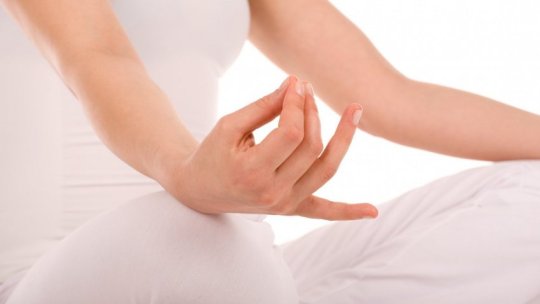
Backaches, stomach pains, discomfort in the calves-- it feels like nearly every person in contemporary Western society has some of type of discomfort that continuously nags them. Yoga has actually entered the West just in the previous hundred years or two, yet its concentrate on achieving wellness via a whole-person overview has a lot to use around. Yoga exercise, in types from Bikram to Yin to Restorative, could assist specialists take care of various kinds of pain. All those forms-- also if rather various on the surface area-- highlight breath, release of unneeded tension, and also healthy motion patterning. Those as well as other facets of yoga could aid people who endure from persistent discomfort return to a much better regular in their body and minds.
Breath is important in handling pain due to the fact that it could assist bring pain into viewpoint, emotionally and also literally. An excellent number of peer-reviewed, empirical mental researches have confirmed that discomfort can seem even worse when anxiety climbs. In the "fight-or-flight" mode, the body is extra-sensitive to feeling-- including pain-- as a survival device. Key to decreasing anxiety is discovering stable, deep breathing, because this activates the parasympathetic (" cool-down," we might call it) part of the anxious system.
That breath doesn't always need to be sluggish, as it needs to give enough oxygen for the needs of the body's current job. By doing this a Vinyasa yoga exercise practice may require a quicker-- yet full, continual, and also rhythmically stable-- circulation of breath than does a Hatha yoga exercise course. The Kalabhati (" bellows") breath, generally a part of Kundalini yoga, helps practitioners create as well as keep the faster flow within that form. In any one of these asana forms, professionals could find out how you can locate the style of breath that suits their demands at today minute. Exercising pranayama workouts could just boost that discovering and also strengthen its associated skills. Via such a process, persistent discomfort sufferers could discover how to mindfully utilize their breath as a device to reduce just what ails them.
Yoga could likewise assist practitioners learn how to release unneeded tension, a main reason of chronic pain, via aiding them to develop extra reliable, anatomically informed movement patterns. That can take stress and anxiety and strain off areas of the body that are demanding mercy via discomfort (read: pain is the body's method of saying, "Please, stop doing that, or get assist to earn it stop!"). For instance, a person has the tendency to raise his/her shoulders (and because of this, tense his/her neck muscle mass) in Tadasana as well as Warrior poses. Surprise-surprise, doing so is a practice in daily life, as well as he or she has persistent migraine headaches. See a link? A yoga exercise instructor can discover this pattern and also, with physical cueing and associated spoken guideline, help the trainee discover how to release his/her shoulders down the back in those positions and also throughout practice.
With a mindful method as well as constant self-correction, the trainee could simply have the ability to carry out that new shoulder placing off the floor covering, in everyday life. The neck muscle mass are not stressed via having to operate in ways they just weren't implied to, with staying contracted to assist elevate the shoulder blades. Hooray, much to the individual's alleviation, the migraines become much less severe and also frequent. That type of process could be really valuable for those that have chronic pain from their work-related obligations, such as athletes, professional dancers, artists, retail workers, building workers, mail service providers, and so on. In similar methods, they might discover how they position a great deal of strain of certain parts of their body through just what they do at the office day in and day out.
Learning new, healthier means of accomplishing physical tasks could first help them to see exactly how moving in certain ways is most likely creating, or at the very least substantially adding to, their pain. New patterns can initially feel weird, however the positive difference is clear before long. A service to-- or at least decreasing of-- their pain is right there in those far better means of removaling. Much more active, "yang" designs of yoga exercise (such as Ashtanga and Power Yoga) offer enough possibility to check out and also develop improved motion patterns via many repetitions of codified positions as well as motion circulations. As an example, it could not be as well far from exact when a trainee really feels like that Chaturanga Dandasana has actually been the 30th of the class!
Yin, or fairly slower and also gentler, forms of yoga exercise (such as Corrective and also Hatha) can supply trainees the time to approach motion in conscious means, experience the body's action, and react accordingly. Flying via a Sun Salutation could be exhilarating, but one can miss a probably refined-- but nevertheless crucial-- physical sensation, such as a sore hamstring or modify in the back. Taking that same sequence extra slowly, or possibly including fewer postures and also motions, can enable a yogi( ni) the time as well as mental area to observe and appropriately react to such sensation.
Beyond these physical realities, yoga exercise offers a psychological element that could be useful for pain management. The yogic values of mindfulness, maintaining feeling in perspective, and focusing could assist individuals to fairly examine such situations, and afterwards to make a prepare for renovation and stick with it. The Niyamas concentrate individuals on personal regards-- important in managing discomfort, because it takes listening to the body's messages to offer it what it needs for the discomfort to reduce. Dharana tests specialists to genuinely focus, as well as dhayana challenges them to devote themselves to a task. All this is necessary for healing any kind of condition, however especially for something persistent and often debilitating such as persistent pain.
All in all, yoga exercise provides physical as well as psychological devices to help ease pain in lots of kinds. Whether rapid or slow, with objectives of health and fitness as well as weight-loss, or relaxation, any kind of form of yoga exercise can supply various-- yet similarly legitimate-- sorts of such tools. Persistent, major clinical problems call for the care of doctor. That being said, let's not forget the wisdom of old yogis. Those tools they produced are vital ingredients in the mix towards real continual healing from persistent discomfort.
Kathryn Boland is a third-year Master's degree trainee in Dance/Movement Therapy at Lesley College (Cambridge, MA), and an E-RYT 500. She is originally from Rhode Island and attended The George Washington College (Washington, DC) for an undergraduate level in dancing (where she first experienced yoga exercise). She has actually shown yoga exercise to varied populaces in diverse places. As a dancer, she has actually always loved to keep moving as well as flowing in practicing a lot more energetic Vinyasa-style types. Her rate of interests have actually lately progressed to consist of Yin as well as therapeutic yoga, and also lining up those types with Laban Motion Analysis to serve the needs of numerous teams (such as Alzheimer's Condition clients, children identified with ADHD, PTSD-afflicted experts, all demographically broadening). She thinks in locating the opportunity within every hardship, as well as doing all that she could to aid others cope with a little bit a lot more breath as well as flow!
0 notes
Photo
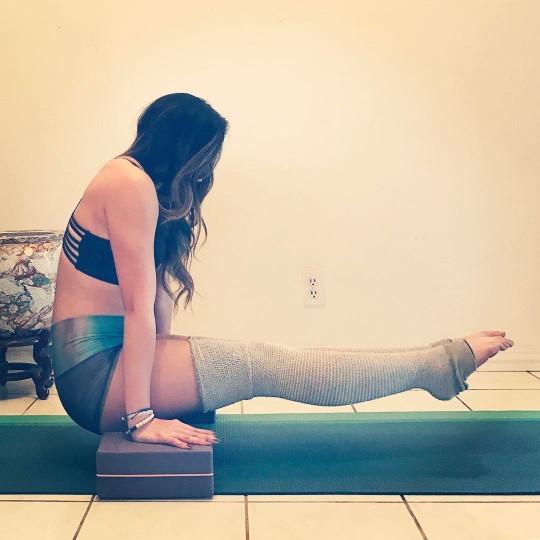
Day 3 of #omstarsyoga is floating stick pose or utpluti dandasana. Dead tired but uhm getting this in now so I can KO when I get home 😴 haha This is one of the poses I absolutely.... loathe. Which means I definitely need this pose in my life 😂 Does anyone else's quads cramp up in this?! Happens so often 🤷♀️ Anywhooo, I get more lift with blocks but even if you can't lift your tush or feet off the floor, the key here is to really engage your core and to push your hands into the mat. Yeah, this pose is hard af. Totally need to practice the transition from this pose to chaturanga doe! '''Tis all for now friends! Love & light to ya ❤✨🙏 Namaste!! Shorts&Leg warmers : @teekigram #yoga #yogi #yogini #yogapractice #yogaeverydamnday #namaste #workout #fit #fitness #fitspo #fitgirls #motivation #inspiration #ootd #teeki #teekigirls #aboutalook #lookbook
#namaste#yoga#fitspo#fit#lookbook#teekigirls#workout#aboutalook#yogi#yogini#yogapractice#yogaeverydamnday#omstarsyoga#fitgirls#fitness#ootd#teeki#motivation#inspiration
1 note
·
View note